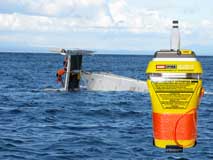Beware! – Emergency Services Will Not Respond
 |
From 1st February, 2009, the International Cospas-Sarsat Program will terminate satellite processing of distress signals from 121.5/243 MHz emergency beacons (EPIRBs and PLBs); only distress signals from the newer 406 MHz EPRIBs and PLBs will be processed. The bottom line is that if you are still carrying one of the 121.5/243 MHz EPIRBs or PLBs in February, and you find you are in significant distress, requiring immediate rescue assistance, don’t bother flicking the switch . . . instead you can make the last entry in your diary: that you should have given yourself a new, 406 for Xmas.
Emergency Position Indicating Radio Beacons (EPIRBs) or Personal Locator Beacons (PLBs) are outstanding safety devices when registered with the International Cospas-Sarsat Satellite System – they provide you with virtually instant and appropriate response from search and rescue services anywhere on the planet. Originally used only by commercial shipping, the modern EPIRB and PLB is compact and inexpensive enough to be carried by all water sports enthusiasts and adventurers who travel far from civilisation.
The newer units use the 406 MHz frequency, which is less prone to false alarms, offers faster and more accurate positioning, and can cost as little as US$350. If you are far out on the water, flying or high in the mountains then it makes good sense to carry an EPIRB or PLB.
For information on the latest EPIRBs and PLBs available in Asia, contact Broadwater Marine in the Philippines and Australia or, speak to your nearest Coast Guard Search and Rescue coordination centre.

